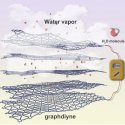Chinese researchers made an original discovery that water (H2O) vapor and graphdiyne material together can generate a collectible induced electricity from "chemical bond conversion". In addition to water vapor, they found the same phenomenom with ammonia and hydrochloride gases.

One of the co-authors, Yuling Li, created graphdiyne, a 2-dimension carbon allotrope, for the first time in the world in 2010.
- The interaction between graphdiyne (GDY) and H2O was found to generate electricity
- The chemical bond conversion causes electron transfer between GDY and H2O molecules
- Other similar molecules have also been shown to generate electricity in this way
Clean, infinitely renewable energy sources with low maintenance requirements that are not subject to geographical restrictions will be an important solution to energy shortages and environmental pollution. The conversion of material has been highly scrutinized by scientists, especially the discovery of some new concepts, new phenomena, and new sciences. We describe here an original discovery from graphdiyne (GDY) material. The conversion of acetylenic bonds with the intervention of H2O molecules generates a collectable induced electricity with an output voltage of 58 mV and a current of up to 203 nA cm2, illustrating an exceptional concept. We demonstrate multiple systems, such as using ammonia and hydrochloride gases to replace moisture, finding that GDY films can generate respectable induced electricity. This unique electrical phenomenon originating from chemical bond conversion potentially provides an unexplored area for new energy research, helping us to better understand the essence of power generation.

One of the co-authors, Yuling Li, created graphdiyne, a 2-dimension carbon allotrope, for the first time in the world in 2010.
科技日报记者:请您介绍一下,究竟什么是石墨炔?这种二维碳材料有哪些优点?
李玉良:石墨炔是一个新的碳同素异形体,是由碳碳炔键(sp碳)将苯环(sp2碳)共轭连接形成二维平面网络结构的全碳材料。
由于具有丰富的碳化学键、大的共轭体系、天然的孔洞结构和本征带隙等特征,石墨炔在生长、组装和性能调控等方面表现出巨大优势和先进性,将是推动催化、能源、光电转换及新模式转换和转化等领域创新性发展的关键材料。
2010年,我们研究团队在世界上首次通过化学合成的方法大规模制备出了石墨炔薄膜,并用“石墨炔”对其进行命名。自此,石墨炔这种自然界不存在的物质第一次真实地呈现在人类面前,为碳材料家族增添了新成员。石墨炔的成功制备结束了合成化学不能制备全碳材料的历史,开创了人工合成新型碳同素异形体的先例,开辟了碳材料研究新领域。




